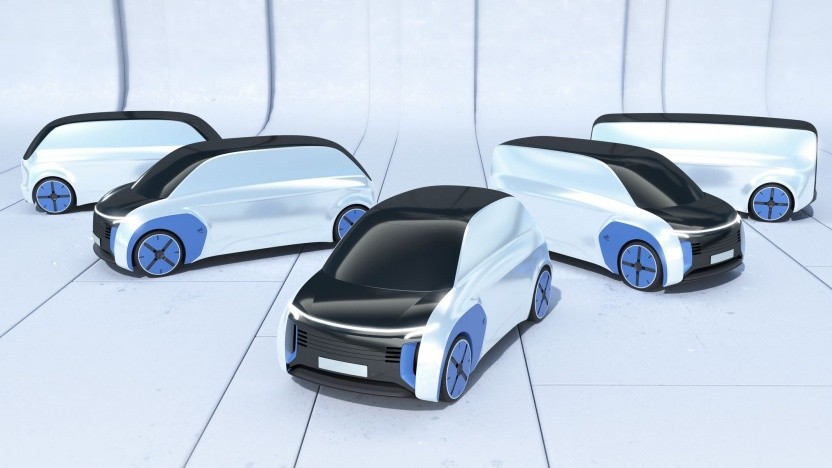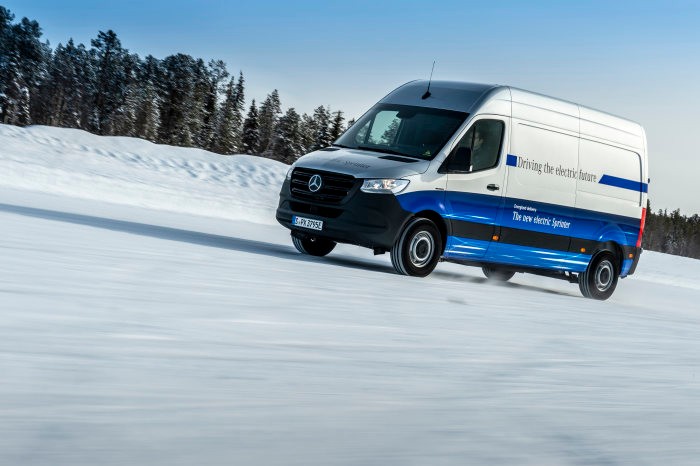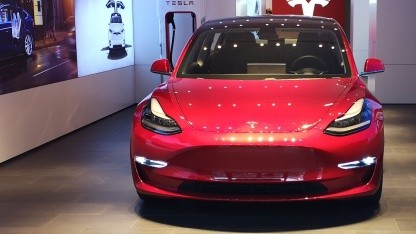Fortum As Norway’s capital city prepares to ensure all taxis are zero emission by 2023, Oslo is setting up a wireless charging system for cabs. It aims to have the first such fast-charging taxi system in the world, though it’s not clear exactly when it will be up and running. Charging plates will be installed… Continue reading Oslo is working on wireless charging for its electric taxis
Tag: Electric vehicles
Tesla drops annual servicing for ‘as needed’ repair model
ASSOCIATED PRESS Tesla has quietly changed its EV maintenance policy, going from regularly scheduled service to an “as-needed” model, according to its “Car Maintenance” page. Before, it called for “recommended” service every 12 months and 12,500 for the Model S and X, and 24 months or 25,000 miles for the Model 3. Now, however, it… Continue reading Tesla drops annual servicing for ‘as needed’ repair model
Tesla Gigafactory employees lined up for ‘Merch Madness,’ a chance to buy company swag on the cheap
Andrew Evers | CNBC
Tesla employees at the company's Nevada Gigafactory line up to buy discounted company merchandise in March 2019.
Tesla set up a pop-up shop just for employees at its Nevada Gigafactory this week, and sold them company swag on the cheap during a series of events it called “Merch Madness.”
The stunt helped boost employee morale during a stressful end-of-quarter push, which followed company-wide layoffs and store closures.
CNBC visited the sprawling battery plant during “Merch Madness” and observed lines to rival the opening day of a new “Star Wars” sequel.
Andrew Evers | CNBC
A screen in Tesla's Gigafactory advertising “Merch Madness,” a chance for employees to buy discounted company swag.
Among the items in the employee-only shop were:
A “Tesla Corporate Jacket,” which Tesla sells on its website for $175, but cost employees just $48 during the eventTesla caps that sell for around $30 at retail, but cost employees $6Items not currently available online, including a Semi Truck tee for $9, leather Corsicana tote bag for $102 and leather touchscreen gloves for $28.
Employees told CNBC they were stocking up on gear they wanted as well as gifts for family and friends. The company store took credit cards only. They get an employee discount year-round but the Merch Madness deals went beyond that, they said, so waiting on line was worth it.
In February 2019, Tesla set up a store to sell its branded apparel and accessories on Amazon.
Increased attention to branded merchandise at Tesla follows success in this arena for another Elon Musk business — The Boring Company sold $10 million worth of its “not-a-flamethrowers” in five days last year, and $1 million in baseball caps.
A spokesperson said that as of the week of March 4, Tesla employed more than 40,000 people. In its 2018 annual report, Tesla said it had 48,817 employees. Tesla has not disclosed exactly how many people it has laid off this year.
WATCH:
The rise of SpaceX and the future of Elon Musk's Mars dream
The rise of SpaceX and the future of Elon Musk's Mars dream
4:01 PM ET Wed, 20 March 2019 | 18:00
Tesla brings back its referral program, sort of
NurPhoto | NurPhoto | Getty Images
Tesla is bringing back its once popular referral program in a new form just months after killing it, the company said.
But the program will be different from its previous incarnation, which Tesla said was too costly to keep up.
For every customer a Tesla owner refers, the company will give both people 1,000 miles of free use of its Supercharger charging network and will enter the referrer into drawings for a special edition of the Model Y crossover monthly and second generation Tesla Roadster quarterly, each signed by Tesla CEO Elon Musk and Chief Designer Franz Von Holshauzen.
“While our previous Referral Program was very successful, it came with significant costs, and ending the program last year allowed us to pass those savings along to customers,” Tesla said in a blog post Thursday night. “We've since restructured the program to save the company money while also offering rewards that are super exclusive.”
The program is not quite as fat with incentives as its forebears. The previous version of the program gave owners six months of free Supercharging with the purchase of a Model X SUV, Model S sedan or Model 3 midsize sedan.
The previous program also gave referrers a chance to win a variety of awards, including having a photo launched into space, new wheels, priority access to software updates and vehicles.
An even earlier version of the program offered some buyers free unlimited Supercharging. The new program gives those participants in the program a two chances to win a new vehicles in each period.
GM plans to make new electric car, spend $300M, hire 400 workers in Lake Orion
Original Article
Next Generation Car: The vehicle of the future is modular
A vehicle needs a cab and a drive. But do they both have to be a single unit? Researcher of the DLR work on different concepts for that automobile the future. One of them is a modular vehicle that can be used for a variety of purposes. from Werner Pluta March 22, 2019, 12:01 pm… Continue reading Next Generation Car: The vehicle of the future is modular
Electric Vans from Mercedes-Benz Vans: Reliable last-mile deliveries even in Arctic conditions
22.
March 2019
Arjeplog, Sweden
Final winter tests show: the eSprinter is ready for its market launch Testing of charging and driving characteristics, range and low-temperature resistance in extreme conditions The focus at sub-zero temperatures: safety and ergonomics of the driver's workplace, reliable handling on ice and snow Comprehensive Electrification at Mercedes-Benz Vans: market launch of the eSprinter in the second half of 2019 Arjeplog, Sweden. Customers place the same demands on electric vans as they do on equivalent vehicles with combustion engines. One of the most important factors here: complete reliability – even in severe conditions. The winter endurance tests on the Mercedes-Benz eSprinter focussed precisely on this. For several weeks the development team subjected the fully-electric van to a true endurance test in Sweden's Arjeplog. At temperatures as low as minus 30 degrees with icy roads and deep snow, the eSprinter proved its operability under extreme conditions. Thus the vehicle completed one of its last milestones on the way to its market launch in the second half of 2019.
The vehicles were put through numerous complex tests on the difficult test site close to the Arctic Circle. Testing included driving on a frozen lake to examine the effects of extreme cold on handling, ergonomics and comfort using special measuring technology. The starting behaviour and low-temperature resistance of the drive components, software and interfaces were tested in cold cell facilities.
How the vehicles respond to different weather conditions is critical to the electric vans functioning in tough daily operations, for example in the CEP sector (courier, express, package). With a range of around 1501 kilometres when configured with a battery capacity of 55 kWh, the eSprinter is perfectly designed for inner-city short-radius distribution. The tests in Sweden have shown: even in the unfavourable conditions described here, a range of around 1001 km is still available to the customer.
Electromobility with Mercedes-Benz standards: high quality and safety demands are placed on the driver's workplace
Anyone who drives a van daily, places high demands on the driver's workplace. That is why quality and safety are equally important for electrically driven vans. Even at temperatures far below freezing, it must be possible to free the windows from ice as quickly as possible and heat the driver cabin reliably. To this end, the temperature of the test vehicles and their batteries was lowered to extremes in special cold cells in order to test the starting behaviour and thermal management during so-called cold starts. A further important element of the test: charging behaviour. The eSprinter is equipped with an integrated fast-charging function with which it can recharge around 80 % of its energy in 30 minutes – this is a great advantage in the daily routine of a van which must function reliably whatever the temperature.
Also, reliable handling in ice and snow as well as resistance of the components to wintry conditions are vital to daily operations. This is exactly what the team of more than 30 engineers, electronics experts and mechanics from Mercedes-Benz Vans have ensured in numerous tests in Sweden's Arjeplog. The conclusion of the testers was that the eSprinter is fit for customer operations – even in Arctic conditions.
“Yet again we asked a lot of our eSprinter during the final winter endurance tests,” says Benjamin Kaehler, Head of eDrive@VANs at Daimler AG. “Thanks to our comprehensive tests, we were able to squeeze out the last couple of percentage points from our second fully-electric van after the eVito on its way to complete market readiness. Particularly with regard to thermal management, so important to electric vans, we were able to gain insights which will make the eSprinter safer and more comfortable. We are very proud of the result and are looking forward to being able to offer our customers an extremely reliable product very soon that is more than suitable for everyday use, regardless of the conditions.”
eSprinter on a par with the founder of the segment
In Arjeplog, the eSprinter was subjected to its final winter endurance tests before it follows the eVito onto the market in the second half of 2019. Initially, the new eSprinter will be available as a panel van with a high roof and a permissible gross vehicle weight of 3500 kilogrammes. Its maximum load volume is 10.5 m³ just like a comparable Sprinter.
Equipped with a battery capacity of 55 kWh, its range is an estimated 1501 kilometres with a maximum payload of 900 kilogrammes. With the second battery option, customers can prioritise other operational parameters. A capacity of 41 kWh allows the payload to be increased by around 140 kilogrammes to a total of 1040 kilogrammes with a range of about 1151 kilometres. The integrated fast-charging function provides for more flexibility; 80 % of battery charge can be recharged within 30 minutes.
Similar to the entry-level diesel engine, the electric drive in the eSprinter has an output of 85 kW and a torque figure of up to 300 Newton metres. As for the eVito, the maximum speed can be configured to suit the task at hand: maximum speed can be set at 80 km/h, 100 km/h or even as much as 120 km/h.
Press Contact
Oliver Fenzl
Van Technology Communications – eDrive@Vans
oliver.fenzl@daimler.com
Tel: +49 (0)711 17-4 54 64
Fax: +49 (0)711 17-52030
Press Contact Overview
Media
Download
Pictures (25)
Videos (1)
Documents (1)
Media Contact (1)
Filter
Show thumbnails
Show list
Slideshow
Zoom
Preview
Details
Do you really want to delete the data record?
Please wait a moment …
Please wait a moment …
Please wait a moment …
Please wait a moment …
19C0202_001
19C0202_002
19C0202_003
19C0202_004
19C0202_005
19C0202_006
19C0202_007
19C0202_008
19C0202_009
19C0202_010
19C0202_011
19C0202_012
19C0202_013
19C0202_014
19C0202_015
19C0202_016
19C0202_017
19C0202_018
19C0202_019
19C0202_021
19C0202_022
19C0202_023
19C0202_024
19C0202_025
19C0202_020
Loading
A European consortium to produce batteries is born
The great unresolved issue of mobility in Europe is the lack of development and production of batteries in the continent. Despite the consensus in the diagnosis of the problem, the initiatives that have been up to now have clashed with multiple trips. But now a new initiative has just broken through by creating an EU… Continue reading A European consortium to produce batteries is born
Electric taxis in Oslo to be charged using wireless technology
K'Nub | Moment | Getty Images
Taxis in the Norwegian capital, Oslo, are set to use wireless fast-charging technology to keep them running.
In an announcement Thursday, Finnish energy firm Fortum said it would work with the City of Oslo and Momentum Dynamics, a U.S. company, to build the system.
The project will use induction technology, with charging plates installed in areas where taxis, which will carry a receiver for the charging, park.
“We will install the wireless chargers at taxi stands, such as the one at… Oslo Central Station,” Annika Hoffner, the head of Fortum Charge and Drive, said in a statement.
“Taxis will be able to drive up to the charger and a wireless charging session will automatically start,” Hoffner added, explaining that taxis could charge while waiting for new customers.
The rollout of a wireless charging system in Oslo is part of a wider transition to cleaner types of transport in the country.
In 2018, there were 46,143 new passenger car registrations for battery electric vehicles in Norway, according to the European Automobile Manufacturers Association.
Sture Portvik, electric mobility manager for the City of Oslo, said that all taxis in Oslo would be zero-emission from 2023.
Cost reductions: Tesla eliminates service intervals
Because the vehicles wear less than expected, lifts Tesla The service intervals for all workshop car dealers that have been valid until now for a workshop check. In addition, the referral program comes back. March 22, 2019, 8:43 am, Andreas Donath A Model 3 in Berlin (Image: Andreas Donath) In the future, Tesla will only… Continue reading Cost reductions: Tesla eliminates service intervals


